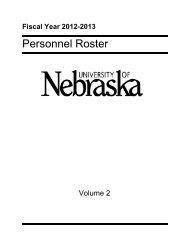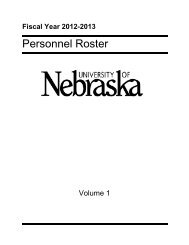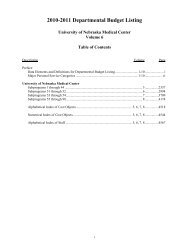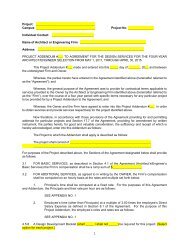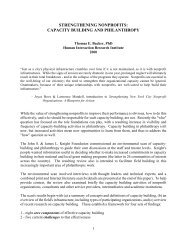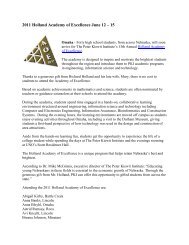Full Version - Water for Food Institute - University of Nebraska
Full Version - Water for Food Institute - University of Nebraska
Full Version - Water for Food Institute - University of Nebraska
Create successful ePaper yourself
Turn your PDF publications into a flip-book with our unique Google optimized e-Paper software.
56<br />
GLOBAL PERSPECTIVES ON WATER FOR FOOD 2<br />
Speakers<br />
A System Approach to <strong>Water</strong> Productivity<br />
Robert T. Fraley<br />
Executive Vice President and Chief Technology Officer, Monsanto Company<br />
Although many people still have a pastoral view<br />
<strong>of</strong> agriculture, unprecedented modern technologies<br />
will meet the growing demand <strong>for</strong> food, Robert<br />
T. Fraley said. He described important advances in<br />
agronomic practices, breeding and biotechnology<br />
research occurring today in U.S. corn production.<br />
Monsanto Company has committed itself to<br />
achieving sustainable agriculture and serving<br />
growers. Part <strong>of</strong> that commitment includes<br />
helping farmers double yields in corn, cotton,<br />
soybeans and spring-planted canola by<br />
2030 – and do so with one-third fewer inputs<br />
per unit <strong>of</strong> output.<br />
For U.S. corn, Monsanto’s goal is to raise yields<br />
from today’s 137 bushels per acre to 300<br />
bushels per acre by 2030. Such gains won’t be<br />
accomplished with a simple technique or<br />
method but through advances in biotechnology<br />
and breeding, as well as systemic improvements<br />
in agronomic techniques.<br />
“It’s important that this technology benefits all<br />
farmers,” Fraley said, from large-scale U.S.<br />
growers to smallholder farmers across Africa and<br />
Asia. “We can see these tools improve their lives,<br />
their pr<strong>of</strong>itability and their cultures and societies.”<br />
In 1970, the year Fraley left his family’s farm,<br />
his father was thrilled that corn yield averages<br />
hit 75 bushels per acre. Today, technology<br />
powers record yields – more than 160 bushels<br />
per acre. “In 2030, we’ll look back at how<br />
we’re growing corn today the same way we<br />
Robert T. Fraley<br />
kind <strong>of</strong> laugh when we look at how we did<br />
it in the 1970s. We’re going to experience the<br />
greatest explosion in the advancement <strong>of</strong><br />
agricultural technology that the world’s ever<br />
seen,” Fraley said.<br />
If productivity gains continue along the historical<br />
trend line, average U.S. corn yields will reach<br />
200 bushels by 2030. However, improvements<br />
in agronomic practices, such as fertilizer<br />
technologies and seed treatments, as well as<br />
advances in breeding using new genetic tools,<br />
will increase yearly baseline gains slightly. New<br />
biotechnology traits will drive gains even further<br />
to the goal <strong>of</strong> 300 bushels per acre.<br />
Inputs are an important part <strong>of</strong> the equation.<br />
Since 1970, new technologies have resulted in the<br />
steady use <strong>of</strong> nitrogen and a dramatic reduction<br />
in pesticide use. Going <strong>for</strong>ward, rainfall and<br />
chemicals will remain steady, and fertilizer<br />
use will rise slightly with increased yields. It’s



